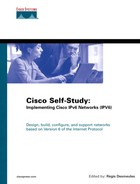Dynamic Host Configuration Protocol for IPv6 (DHCPv6)
Dynamic Host Configuration Protocol (DHCP) has been updated to support IPv6. DHCPv6 can provide stateful autoconfiguration to IPv6 hosts. DHCPv6 handles the addressing architecture and new features of the IPv6 protocol as follows:
It enables more control on nodes than stateless autoconfiguration.
It can be used concurrently on networks where stateless autoconfiguration is available.
It can provide IPv6 addresses to hosts in the absence of routers on a network.
It can be used for network renumbering.
It can be used to delegate /48 or /64 prefixes to Customer Premises Equipment (CPE) routers such as a home gateway.
The process of getting IPv6 configuration data with DHCPv6 for an IPv6 host is similar to that in IPv4, but with a few exceptions. For example, the IPv6 host first detects the presence of IPv6 router(s) on the local link. One of two things occurs:
If an IPv6 router is found, the IPv6 host examines the router advertisement messages to determine if DHCPv6 (stateful autoconfiguration) can be used:
- If DHCPv6 can be used, the IPv6 host (a node with DHCPv6 client support only) sends a DHCPv6 solicit message to the all-DHCPv6-agents multicast address (FF02::1:2) on the local link using its link-local address (FE80::/10) as the source address.
- If DHCPv6 cannot be used, the IPv6 host uses stateless autoconfiguration to configure its IPv6 address using the prefix advertised in the router advertisement messages.
If the local link has no IPv6 router, the IPv6 host (a node with DHCPv6 client support only) sends a DHCPv6 solicit message to the all-DHCPv6-agents multicast address (FF02::1:2) on the local link using its link-local address (FE80::/10) as the source address.
